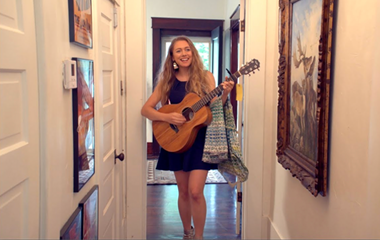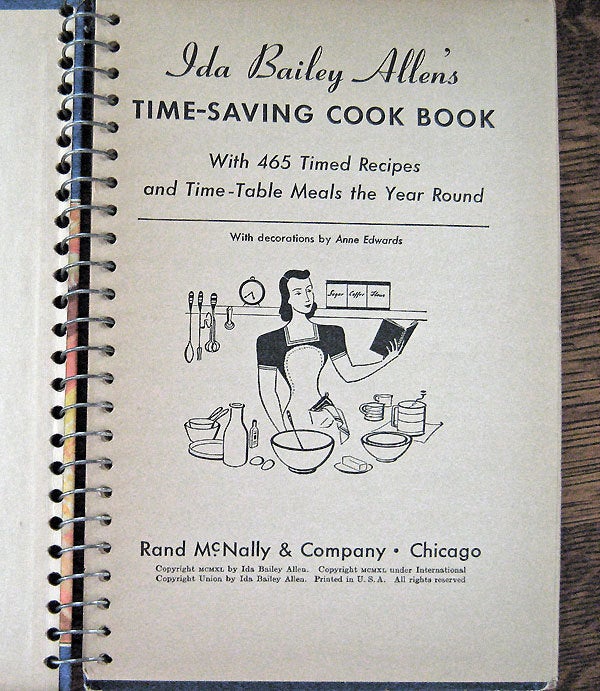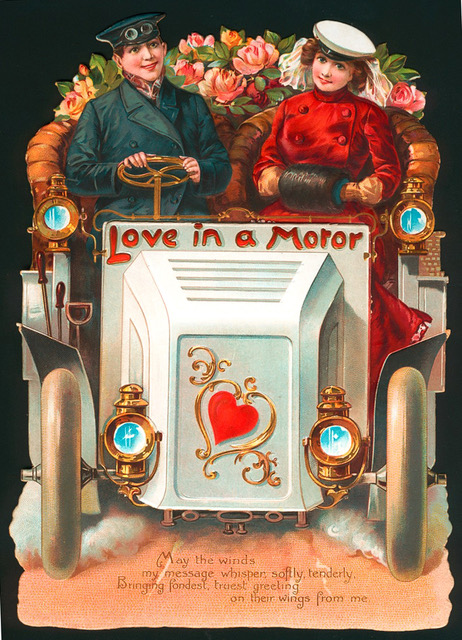We see a lot of vintage cast iron at estate sales, and it’s always one of the first things to go. The cast iron trend has been heating up for well over a decade. But what’s the big draw? To learn more about cast iron cookware and why vintage cast iron is worth collecting, we did some research and reached out to the women behind The Pan Handler LLC to find out why it’s so hot.
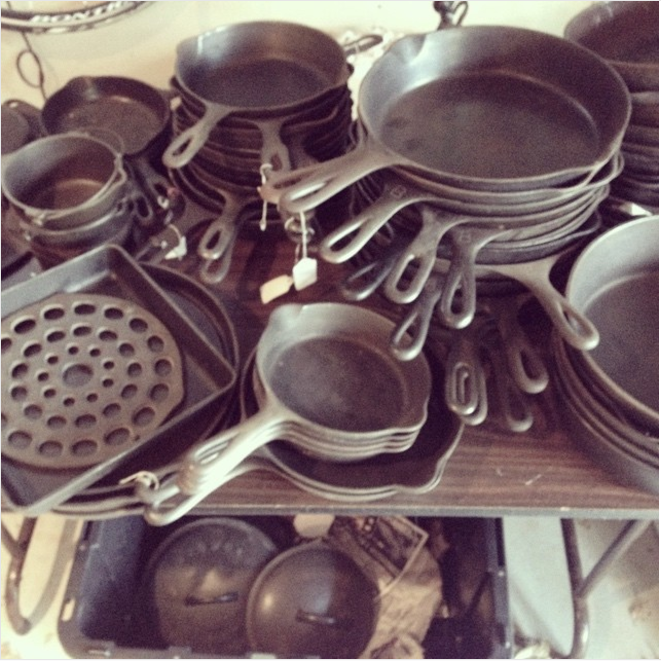
Recent Food Trends
Food used to be for sustenance. Now it’s a status symbol. There seem to be a million more cooking shows than there were years ago. There’s even an entire channel dedicated to food. Could this be one reason behind the cast iron craze?
“I think that how food has become a thing is definitely a contributing factor because it’s made more people interested in cooking,” said Anna H., who took over The Pan Handler LCC from Mary T., where she sells vintage and antique cast iron, as well as runs The Pan Handler blog.
Many celebrity chefs prefer cooking with cast iron, and even endorse certain brands, so it makes sense people have jumped on the bandwagon, looking for cast iron at estate sales, in flea markets, and online.
People are also getting savvier about what they put into their bodies and making healthier decisions. Many old unhealthy practices are relics from past decades. Think: microwaves, margarine, and TV dinners. Teflon,too.
While it was great for non-stick cooking, it’s been linked to disease. Cast iron doesn’t leach harmful chemicals into the food. In fact, if it leaches anything, it’s iron, something you could use more of.
Vintage Cast Iron is Highly Collectible
Take it from cast iron collectors who have been at it for awhile. Mary T. even collects vintage stoneware, which is how she first stumbled onto vintage cast iron. She was shopping at Goodwill when she saw a Griswold Gem pan and got curious.
“I didn’t know anything about it, and I kind of just stopped in and bought it. And when I got home and I looked at it, the casting on it was just beautiful, and I liked the markings on it. I liked the way it looked. When I compared it to cast iron of current day, it was such a finer quality, and i just was really drawn to it,” Mary T. said.
Afterwards Mary bought sixty pieces of cast iron on an auction and learned how to clean and season it. It was just the beginning. From there, she started The Pan Handler LLC, a thriving small Internet business. Despite having sold the business to Anna H., Mary continues to blog about vintage cast iron on her new website.

Vintage Cast Iron Is Earth-friendly
Taking care of the environment is important. Ever since the 60s and 70s, cast iron has been popular with the outdoor types and hippies, and now it’s gone mainstream. Because cast iron is so durable, it will last forever.
“I like the idea of reducing, reusing, recycling. So I like the fact that I’m not buying something that’s going to end up in a landfill,” said Mary T.
Why buy a new pot or pan when a cast iron pan cooks just as well (if not better) and will last a lifetime? Its versatility, too, means you don’t need to buy a bunch of “uni-task” tools or cookware.
Cast Iron has a Rich History
Vintage cast iron’s interesting history alone is worth collecting. Cast iron has been around as long as 5 B.C.E, when the Chinese used it for cooking. Cast iron was used all over Europe throughout history, and we still use cast iron Dutch ovens today.
Cast iron also has strong ties to American history when the colonists used cast iron cookware on open fires. Some people are interested in the individual stories of who once owned each piece, and the journey it took to end up in their kitchen.
“I like thinking about where it might have been used, and who might have used it. If you look at The Pan Handler blog, you’ll see a bunch of pictures from the Library of Congress in there and photographs of people using these old pieces of cast iron. . . photographs of tenant farmers that during the Great Depression made little meals on the side of the road in their cast iron,” said Mary T.
She also said Lewis and Clark used cast iron on their big expedition, and that in early America, people would carry their antique cast iron skillets across the country in their covered wagons. Some of them still exist today.
Cast Iron Makes Great Family Heirlooms.
Another reason why cast iron is popular is because they make great family heirlooms. You may have inherited a few pieces yourself and want to continue to pass them on. Or you’re looking to buy vintage cast iron—or possibly even new cast iron—that can stay in the family.
“Besides maybe jewelry, because of modern technology and furniture styles and such, there’s not a lot in terms of family heirlooms can be re-used without appearing out of date,” Anna H. pointed out.
“And it’s something that retains its function regardless of what generation you are,” she said.
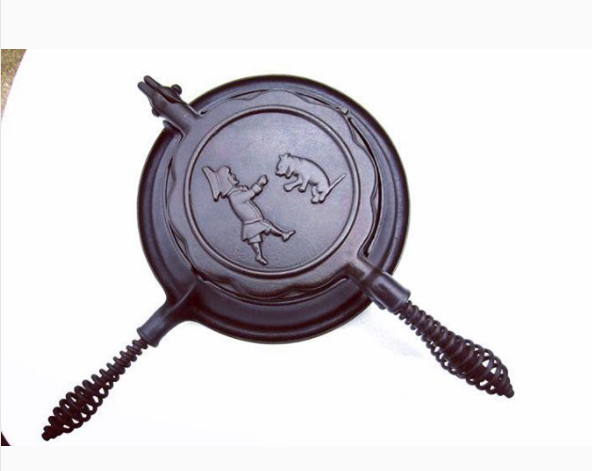
Modern vs. Vintage Cast Iron
Not everything new is better, but that doesn’t mean modern cast iron is worthless either. Good quality craftsmanship gives a piece its value, and as with everything else, old jewelry and vintage engagement rings for example, people once had more time to spend on labor, resulting in finer products.
These days, machines have to do the work of artisans since costs are too high to create each piece by hand. While modern cast iron will also last a lifetime and be fully functional, it just won’t have the attention to detail and craft found in vintage.
How was Vintage Cast Iron Made?
In the 1800s and 1900s, all cast iron cookware was made by hand. Sand molds were formed and iron was melted down and usually combined with scrap iron and/ or steel. Then the mixture was hand poured into a mold, which is the “casting” part of “cast” iron. Doing this by hand allowed for more control, resulting in lighter cookware (modern cast iron can be several pounds heavier). Hand pouring was also key to designing more intricate cookware.
Then the iron has to solidify a.k.a. “controlling the cooling curve,” an important part of the process. If something goes wrong during this stage, the entire project can be thrown. Like if gas gets into it and forms bubbles, a common imperfection in older cast iron pieces.
The way cast iron cools also factors into the final product. Low quality cast iron pieces often haven’t been cooled evenly. Quick cooling produces a finer grain, while slow cooling produces a coarse grain. Once you’ve been collecting cast iron for awhile, you learn all the nuances.
After cooling, vintage cast iron cookware would get smoothed down (also by hand) with a grinding stone, or milled, to make the pan’s surface flat and slick. Collectors refer to this as a “mirror” or “satin” finish, which is one way to distinguish a well-loved vintage cast iron piece.
These days, when everything is produced for the bottom line, cast iron is made with a machine, which means the attention to detail when done by hand gets lost. That’s why machine-made modern cast iron has a rough, pebbly surface, and can weigh a ton.
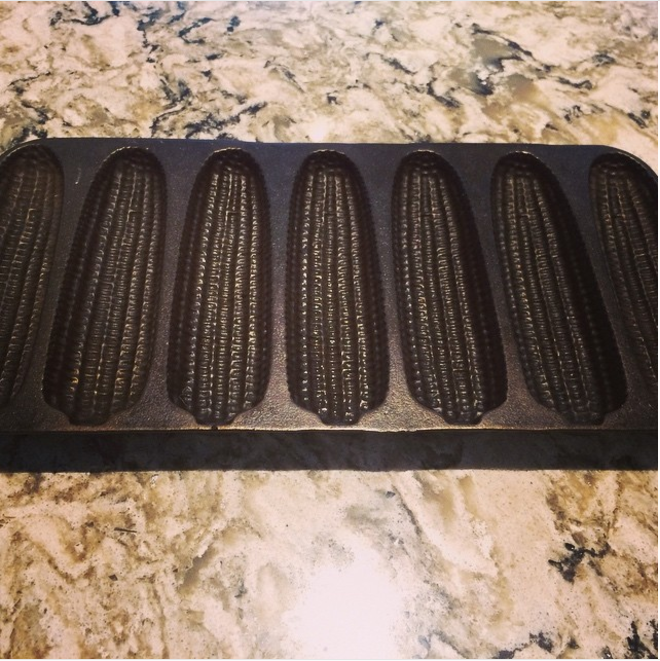
Common Myths about Cast Iron
There are lots of rumors out there regarding cast iron, which is bound to happen when anything gets popular. Anna and Mary from The Pan Handler LLC have heard them all. Here are some of the biggest myths:
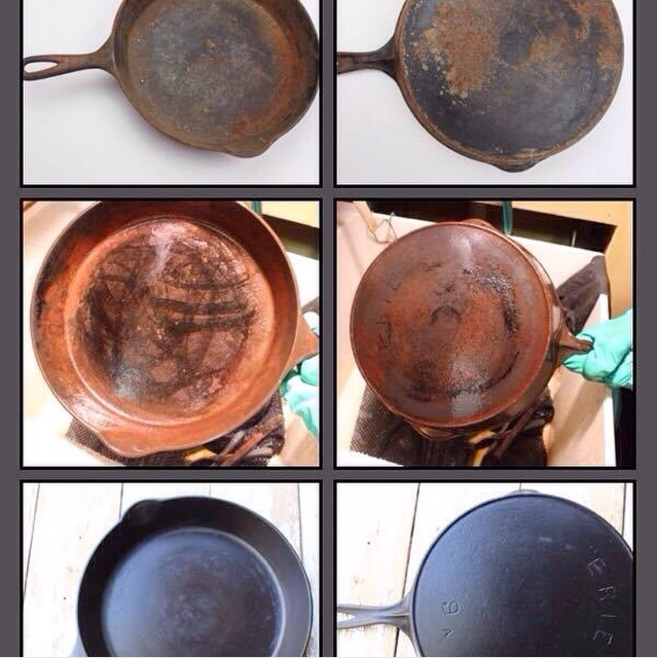
1. Cast iron is hard to clean.
Many people steer clear of cast iron because they think it’s difficult to clean and maintain. But that couldn’t be further from the truth! Any cast iron pro will tell you, keeping cast iron clean isn’t rocket science.
“Because the seasoning makes it non-stick, it’s actually a lot easier than a normal pan. So I inherently spend less time cleaning my cast iron that I use every day than I do on any other nonstick or aluminum cookware,” said Anna H.
2. You have to season cast iron when you buy it.
Manufactured cast iron comes seasoned already, and professional cast iron dealers go many lengths to restore and season vintage cast iron before selling it. If you must season it yourself, go ahead. But if you want to get cooking, most cast iron is ready to go.
3. You can never use soap on cast iron.
While we don’t endorse a long soak, a little bit of dish soap won’t hurt your cast iron cookware. This dirty caveat tends to be the thing most people think of when they think about cast iron.
“Sometimes you need a little bit of soap to get some of the more stubborn food particles off,” said Anna H.
“You season your pan every time you cook in it with some fat, so the seasoning builds up over time. And it becomes quite hardy, and it’s going to reseason the next time you cook in it as well, so it’s much better to get the food off your pan and not have it stuck on for the next hundred years than it is to worry about your seasoning,” said Anna H.
She says a drop or two of normal dish soap should do the trick.
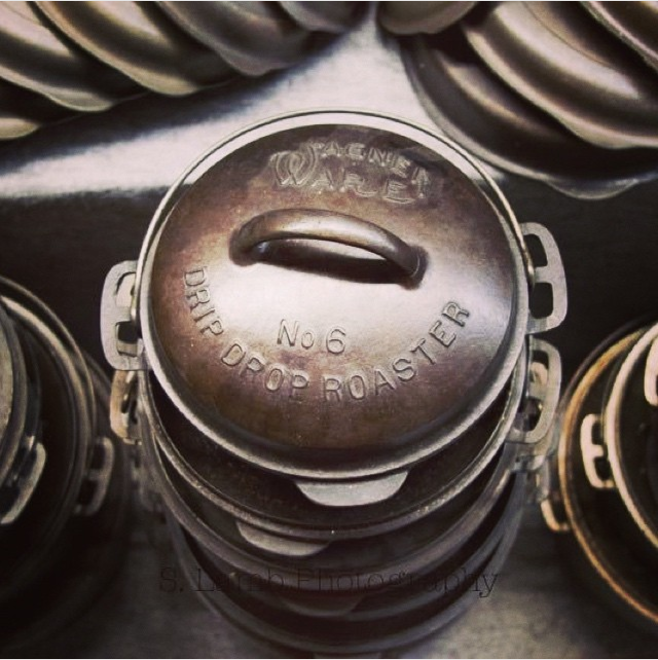
4. You have to clean and put it away after every use.
If cast iron gets used every day, it might not make sense to put them away after every single meal. A simple wipe-down after every use should suffice. Most cast iron is so lovely it doesn’t look bad sitting out, especially for a rustic kitchen look.
“I have a chain mail scrubber that I use to clean them afterwards and I’m not scared of using a drop of soap,” said Anna H. who admits her cast iron “lives” on her stove since she uses it so often.
“The most important thing I do is I dry them immediately after I wash them up, and I pop them back on my stove. If I’m going to be using them again in couple of hours, I don’t do anything else. But if say we’re going away, or it might be a couple of days before I cook, then I’ll spray them with Pam, and wipe them down with olive oil once, and let them sit there until the next time I need them,” she said.
5. Some cast iron is beyond restoration.
While it’s true cast iron can be warped, chipped, or pitted from heat, cast iron has to go through quite a lot to not be functional. This is part of its beauty. Mary T., who admittedly has special tools to restore cast iron, shared a story of the toughest piece she had to get back into shape, a piece that had been buried knee deep in a farm yard. Some people might have tossed it—but not her!
“The process I used for removing rust [from cast iron] was typically electrolysis . . . and a lye bath. (1) The first step, I would place the piece in this lye bath and sometimes it would be in there for weeks, if not months, (2) just taking it out every now and again, and cleaning some of the crud off, putting it back in, taking it out, cleaning some of the crud off, putting it back in and (3) then the final step was the electrolysis. After the electrolysis, (4) I would clean it, and (5) then season it, and then boom! It’s ready to go.”
“So it goes from sitting in the ground in someone’s farm yard to someone’s table!”
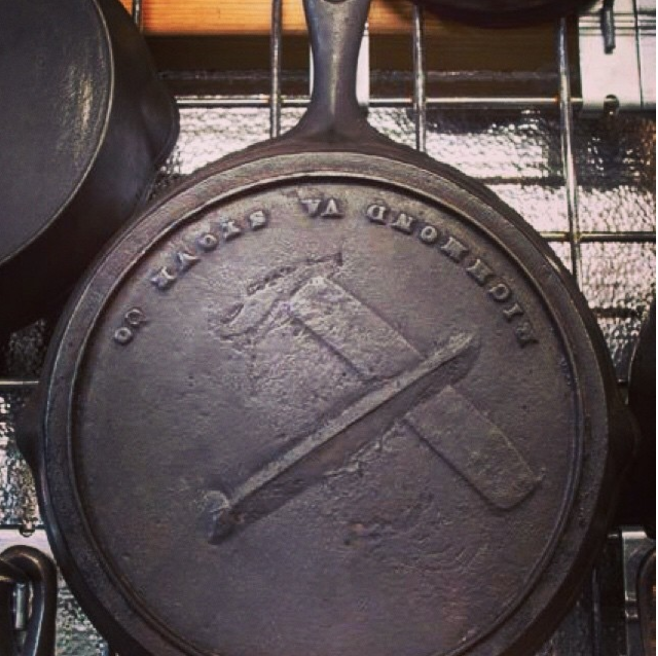
Tips for Buying Vintage Cast Iron
It can be overwhelming to buy cast iron, especially for a newbie. Here are a few tips from the pros on what to look for:
1. Gate Marks
Gate marks mean it’s the real deal: older than 1880 and a true antique. Gate marks were remnants from the casting process, when the piece would “break the mold.” It looks like a slit or gash. If you find cast iron with a gate mark, it hardly matters who the maker is — it’s valuable!
2. Heat Rings
Cast iron pans were originally designed to fit on top of wood stoves. Heat rings are around the pan’s rim were meant to raise the cookware so it didn’t directly touch the stovetop. Cast iron with heat rings is vintage because it was made with wood stoves in mind.
3. Maker’s Marks
Of course Maker’s marks are great ways to identify vintage cast iron and to learn more about a piece’s history. This Pan Handler blog post has a great post on identifying both marked and unmarked antique cast iron cookware.
4. Warping
Over time from improper misuse or storage, it’s possible for vintage cast iron to become warped. If cookware is warped, it won’t distribute heat evenly, which kind of defeats the purpose. Cast iron collector Culinary Fanatic has an informative video on identifying warped cast iron.
5. Made in America Label
If you go to many estate sales, you’re bound to come across cast iron with “Made In America” stamped on the underside. This means it’s likely the piece was made around 1960 or afterwards.
“So that means it’s a little less vintage, but you can also be sure that the pan was made in America and it’s not a cheap Asian pan,” said Anna H.
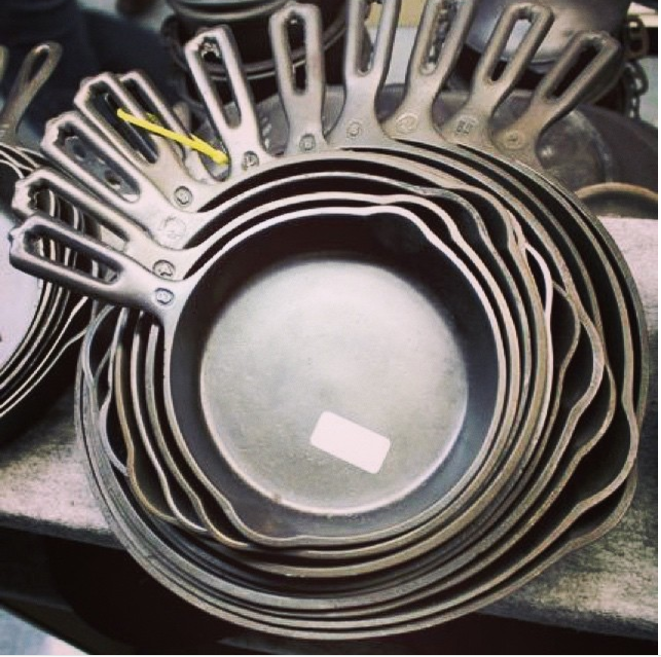
The Reasoning Behind Seasoning
Spend five minutes around cast iron lovers, and you’ll hear about seasoning. What the heck is it? Isn’t seasoning the process of adding flavor to food? Yes and no.
Seasoning is also the process of coating a cast iron pan or skillet’s surface with oil and cooking it off in order to produce a non-stick surface you can use again and again. The high heat causes the oil to solidify (forming a “polymer”) on top of the surface, producing that nice thick coating.
After very thinly oiling the pan (so thin it might not look like it’s there), place it face down in the oven and bake on ~350 degrees for about an hour.
Then you rub the surface dry with clean dry towels (make sure it isn’t still hot) to soak up the excess oil The surface should be matte, not glossy. Preseason if needed until you get the finish you’re looking for.
Know that cooking with it too will produce the coating (about five times should do the trick—an incentive to start makin’ bacon) so don’t hesitate to get started, especially when much of the cast iron you buy, whether vintage (from a dealer) or modern, will be pre-seasoned and ready to go. Some aficionados swear by flaxseed (while others say it flakes off), but other oils includ canola, coconut, and shortening. The debate lives on.
Vintage Cast Iron Brand Names
Not all cast iron brands are the same. There’s a reason you hear about the same brands over and over (Griswold, Wagner, Wapak, Lodge). They’ve stood the test of time. Of course some vintage cast iron brands are no longer in production, and there are a lot of fakes out there to be aware of.
“To me, Griswold is the most collectible of the cast iron cookware, to me the Griswold pieces are the finest made, the most beautiful and in my experience as a seller, that is also the brand that most people want, most buyers want,” said Mary T.
Anna H. also likes Griswold cast iron: “I like the feel of their pans, and the sizes work well for me and they have a solid reputation and they’re very collectible. . . I also have one particular pan, Oneta, and that was by the manufacturer Wapak, and there aren’t a lot of those around, but the pan I have is so light and is such a delight to work with,” she said.
And don’t forget about Lodge, if you’re into the new cast iron. (The cast iron collectors we talked to weren’t).
“We do have some Lodge, it seems like the hot thing everybody wants, but mostly old Lodge,” said Marg O’Neil, cast iron collector and Cast Iron Museum curator.

The World’s Only Cast Iron Museum
Did you know there’s a family-owned Cast Iron Museum? It’s in Tacoma, Washington, run by Larry and Marg O’Neil, avid cast iron collectors. They have so much cast iron—we’re talking 13, 000 pieces of cast iron (!!) that they had to build a 3500 square foot building, and then another building across twenty acres to showcase and sell their finds.
They got into collecting cast iron because of Larry, but they also like the camaraderie, a big reason why people become collectors. The O’Neils belong to a wide network of cast iron lovers, the Griswold and Cast Iron Cookware Association (G&CICA), who get together several times a year to share pieces, ask questions, share knowledge, and make friendships.
“We just had a convention in Springfield, Missouri, so we had a Show and Tell. People bring items and they say, We don’t know what this is, or maybe you don’t find very many of them, and then we have a couple seminars on, like one was on Erie skillets and another one was on G.F. Filley pans, and then we have an auction,” said Marg.
Whether you get into vintage cast iron for the craftsmanship, the cooking, the camaraderie or its interesting cultural past, it’s a hobby worth pursuing and a way to connect to something larger.
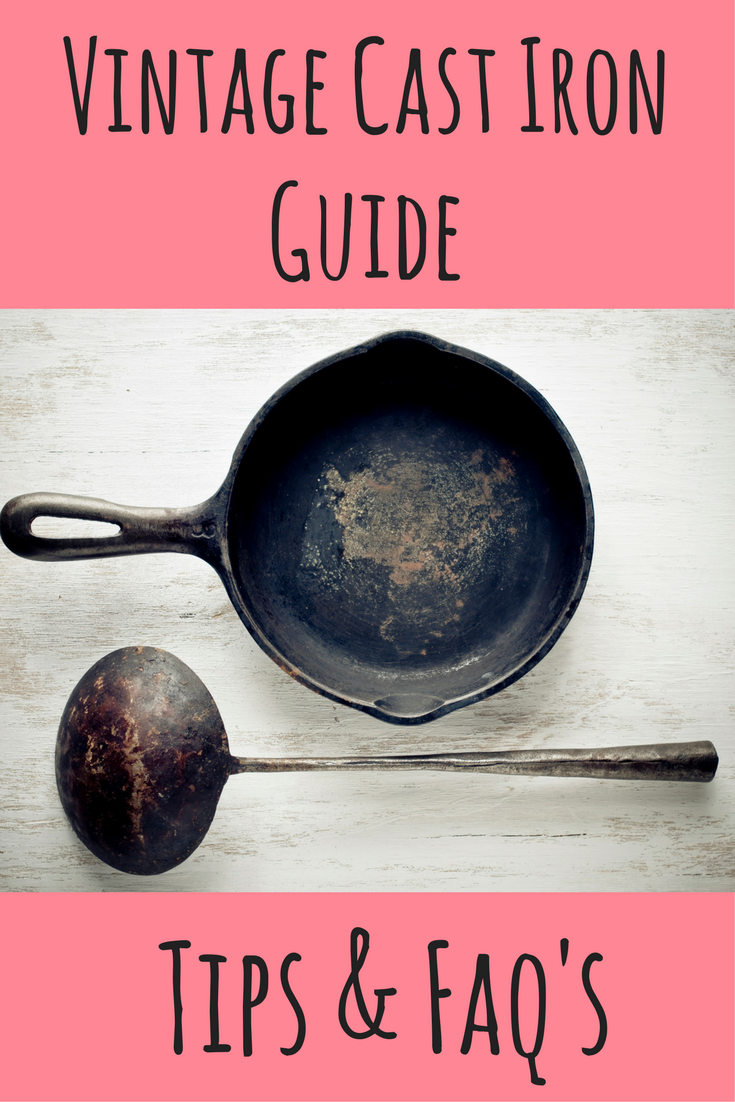
Do you look for vintage cast iron when you go to estate sales? What pieces have you been lucky enough to find? Let us know!
